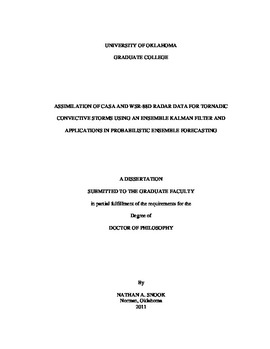| dc.contributor.advisor | Xue, Ming | |
| dc.creator | Snook, Nathan A. | |
| dc.date.accessioned | 2019-04-27T21:26:14Z | |
| dc.date.available | 2019-04-27T21:26:14Z | |
| dc.date.issued | 2011 | |
| dc.identifier | 99190160102042 | |
| dc.identifier.uri | https://hdl.handle.net/11244/318686 | |
| dc.description.abstract | Two sets of experiments are performed to examine the ability of a storm-scale numerical weather prediction (NWP) model to predict precipitation and meso-vortices within the tornadic mesoscale convective system (MCS) that occurred over Oklahoma on 8-9 May 2007, when the model is initialized from ensemble Kalman filter (EnKF) analyses assimilating conventional and/or radar observations. Radar data from multiple networks are assimilated, including data from the X-band radar network of the Engineering Research Center for Collaborative and Adaptive Sensing of the Atmosphere (CASA) and the WSR-88D S-band radar network. The first set of experiments uses an independent ensemble for each experiment, while the second set nests each ensemble experiment within an outer-grid ensemble to provide variation in initial and boundary conditions. A variety of ensemble configurations are used during the analysis and forecast to evaluate the impact of assimilation of CASA and WSR-88D radar data, variation within the data assimilation system, and variation of the model, including changes to the model microphysics. In each experiment, radar data and/or conventional weather observations (i.e. surface, wind profiler, and upper-air observations) are assimilated every 5 minutes for 1 hour. Ensemble forecasts are then performed and probabilistic forecast products generated, focusing on prediction of radar reflectivity (a proxy of quantitative precipitation) and meso-vortices (an indication of tornado potential). This work is the first assimilating real CASA data into a NWP model using EnKF. | |
| dc.description.abstract | While the assimilation of WSR-88D data alone is able to produce a reasonably accurate analysis of the convective system, assimilating CASA data in addition to WSR-88D data improves the representation of storm-scale circulations, particularly in the lowest few kilometers of the atmosphere, as evidenced by analyses of gust front position and comparison of modeled and observed radial velocity. Assimilating CASA data decreases RMS innovation of the resulting ensemble mean analyses of radar reflectivity, particularly in early assimilation cycles, suggesting that assimilation of CASA data allows the EnKF system to more quickly achieve a good result. Use of multiple microphysics schemes in the ensemble during data assimilation is found to alleviate under-dispersion by increasing the ensemble spread. | |
| dc.description.abstract | For the single grid experiments, the ensemble assimilating data from both CASA and WSR-88D radars and using a mixed-microphysics ensemble during data assimilation produces the best probabilistic meso-vortex forecast, while the best meso-vortex forecast of the nested grid experiments is produced by the ensemble using an increased rain intercept parameter. Both of these ensembles predict maximum probabilities of greater than 0.65 of a significant near-surface vortex, with the highest probabilities clustered tightly around the location of the tornadic meso-vortex observed at 0400 UTC. Use of multiple microphysics schemes within the ensemble aims to address at least partially the model physics uncertainty and effectively plays a role of flow-dependent inflation (in precipitation regions) during EnKF data assimilation. | |
| dc.description.abstract | Sensitivity to the assumed observation error used during EnKF data assimilation is noted in the nested-grid experiments. Experiments using assumed observation errors of 2 ms-1 for radial velocity and 3 dBZ for radar reflectivity are found to produce substantially better ensemble forecasts (both in qualitative structure and in quantitative skill score analyses) than an experiment using lower values of assumed observation error. The forecast ensemble assimilating only conventional data performs substantially worse than those ensembles assimilating radar data, but still retains useful skill (verified using the relative operating characteristic skill score) throughout the 3-hour forecast period. Though a bias toward stronger precipitation is noted in the ensemble forecasts, all experiments produce skillful probabilistic forecasts of radar reflectivity on a 0-3 hour timescale as evaluated by multiple probabilistic verification metrics. Though only a single case is studied herein, these experiments represent an important step toward an operational EnKF-based ensemble analysis and probabilistic forecast system to support convective-scale warn-on-forecast operations. | |
| dc.format.extent | 214 pages | |
| dc.format.medium | application.pdf | |
| dc.language | en_US | |
| dc.relation.requires | Adobe Acrobat Reader | |
| dc.subject | Doppler radar | |
| dc.subject | Tornadoes--Forecasting | |
| dc.subject | Thunderstorm forecasting | |
| dc.title | Assimilation of CASA and WSR-88D Radar Data for Tornadic Convective Storms using an Ensemble Kalman Filter and Applications in Probabilistic Ensemble Forecasting | |
| dc.type | text | |
| dc.type | document | |
| dc.thesis.degree | Ph.D. | |
| ou.group | College of Atmospheric & Geographic Sciences::School of Meteorology | |
